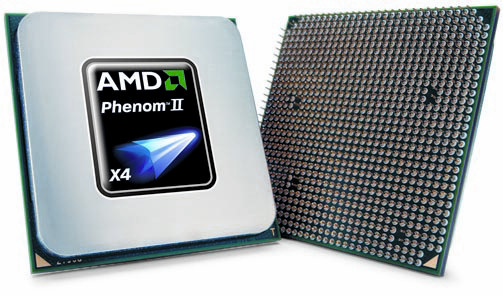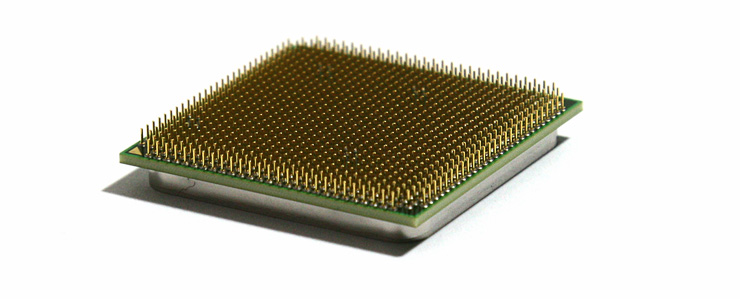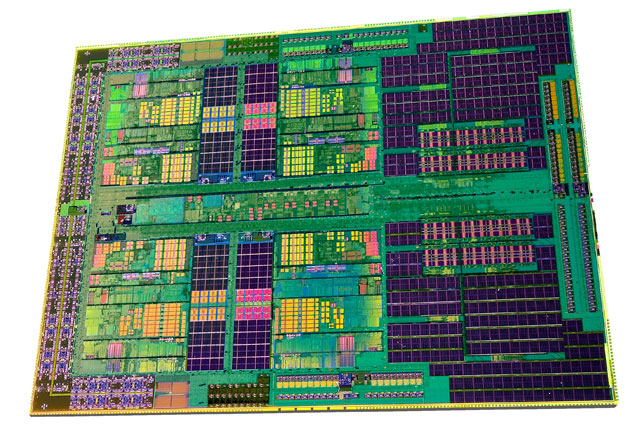|
AMD Phenom II Processor
(X4 940 3.0Ghz)
 AMD have finally
released the next generation of Phenom processors, with the
Phenom II
that ups the ante of this powerful series and is now finally available for the
wider community. AMD are also targeting this CPU towards gamers and best
of all, the processors are still quite affordable when compared to
competitor Intel.
For now, AMD are releasing two
Phenom II processors
which include the AMD Phenom II X4 920 (2.8Ghz) and the AMD Phenom II X4
940 (3.0Ghz), both two powerful CPU's and equally quite affordably
priced. The AMD Phenom II is also a quad
core processor that works in conjunction and independently that when not
used, powers down, ensuring better power utilization though the use of
Hyper Transport technology. If something requires more power, it simply
activates the relevant cores that is ideal for number crunching, photo
manipulation and of course high-end gaming.

The Dragon Platform
With two of the world's
leading CPU (AMD) and graphic (ATI) card designers now joined, a new
platform for users is available called "Dragon" which provides a linked
solution with the AMD CPU (Phenom II), the AMD mother chipsets (790
Series) plus the ATI/AMD graphics cards (AMD ATI Radeon 4800 Series).
This unity will allow for improved performance under the one banner and
is definitely an interesting premise as it reduces the issues of
compatibility problems. Best of all, it's quite affordably priced
compared to the competition and in turn very powerful which I'm sure
gamers will embrace.

Although the original
Phenom processors did have some issues, AMD have addressed these issues
and have created an all-round CPU that is ideal for home users,
designers and of course gamers.
Briefly in terms of changes, AMD have
revised the core architecture of the Phenom II and uses 45nm
architecture (the original Phenom used 65nm) which allows for improved
performance, heat dissipation and higher frequencies but the largest
improvement is the jump from 2MB L3 cache to 6MB.
Also, with the 45nm
architecture incorporated into the Phenom II, it has a peak of 125 Watts
when all four cores of the processor are utilized that is a slight
improvement over the pervious Phenom processors. Needless to say, the
incorporation of 45nm architecture plus 6MB of L3 cache ensures for
higher computing performance without the risk of overheating.

Handling memory by the processor has been dramatically improved with the
Phenom II which means improved bandwidth, faster processing and better
optimization. Cool 'N' Quiet returns to the Phenom II with "Cool 'n'
Quiet 3.0" that assists
in power saving which basically disables certain parts of the CPU when
not in use.
With that said, Cool 'N' quiet 3.0 is definitely an interesting feature as
it switches between a variety of MHz frequencies and power voltages,
ensuring some decent power savings. Gamers or those using CPU grunt can
rest assured that this is enabled for gaming or number crunching.
Phenom II Features / Specifications
-
Processor Frequency: X4 940 (Black Edition) = 3.0GHz / X4 920 = 2.8GHz
-
L1 Cache Sizes: 64K of L1 instruction and 64K of L1 data cache per core
(512KB total L1 per processor)
-
L2 Cache Sizes: 512KB of L2 data cache per core (2MB total L2 per
processor)
L3 Cache Size: 6MB (shared)
-
Memory Controller Type: Integrated 128-bit wide memory controller *
-
Memory Controller Speed: Up to 1.8GHz with Dual Dynamic Power Management
-
Types of Memory Supported: Support for unregistered DIMMs up to PC2 8500
(DDR2-1066MHz)
-
Memory Bandwidth: Up to 17.1GB
-
HyperTransport 3.0 Link: One 16-bit/16-bit link @ up to 3.6GHz full
duplex (1.8GHz x2)
-
HyperTransport 3.0 Bandwidth: Up to 14.4GB/s
-
Total Processor Bandwidth: Up to 31.5 GB/s total bandwidth
-
Packaging: Socket AM2+ 940-pin organic micro pin grid array (micro-PGA)
-
Fab location: Fab 36 wafer fabrication facilities in Dresden, Germany
-
Process Technology: 45-nanometer DSL SOI (silicon-on-insulator)
technology
-
Approximate Transistor count: ~ 758 million (45nm)
-
Approximate Die Size: 258 mm2 (45nm)
-
Max Ambient Case Temp: 62° Celsius
-
Nominal Voltage: 0.875 - 1.5 Volts
-
Max TDP: 125 Watts
*NOTE: MC configurable for dual 64-bit channels for simultaneous
read/writes
As you can see from the above specification from
AMD, the Phenom II is no slouch when it comes to design and offers a
variety of powerful features.
The most noticeable changes to the Phenom II processors is the move from
65nm to 45nm which has also increased the transistor count to an insane
758 million and of course the jump from 2MB to 6MB which adds to the
performance of your system.
For users of existing AM2+ motherboards or
Phenom processors, they can easily upgrade their CPU without the need
for purchasing a new and expensive motherboard which is definitely a
powerful edge when compared to Intel. Of course owners of AM2+
motherboards should check with their manufacturers whether the Phenom II
is supported or if a BIOS update will be made available. (A list is
available at the end of this review)
The only real
issues for owners of AM2+ motherboards is that they will need to upgrade
their motherboard if they are to use DD3 memory. Needless to say, AMD
continues its ideology of backward compatibility which in our eyes is a
very powerful feature that Intel do not offer.
In order to test AMD's most powerful CPU, AMD
organized a Phenom II X4
940 Black Edition processor and
a Gigabyte
GA-MA790GP-DS4H. To complete the Dragon platform, we used a AMD/ATI
Radeon 4870X2 to hear the dragon roar.
Our system also
has 4GB of RAM (Corsair), 500GB SATA Hard Drive and the operating system installed
was Microsoft Vista Ultimate (64-bit) with Service Pack 1. The 4870 X 2 card
also boasted the latest drivers from ATI, ensuring that our system was
up to date.

The first program we used to test the Phenom II was Sisoft SANDRA 2009
which stands for the System ANalyser, Diagnostic and Reporting
Assistant) and is a system diagnostic utility and gives the user
detailed information about their hardware, software and other devices.
It's definitely one of the preferred benchmarking programs for reviewers
and system testers as it allows the user to test a variety of system
features such as CPU calculations and other memory tests. The best aspect
of SiSoft's SANDRA 2009 is that it is compliant with the latest
processors and means quad core processors can finally be tested
without any limitations.
As you can see from the below results, the
Phenom II is quite powerful when all cores are in use. The Dhrystone and
Whetstone results are very impressive as this uses the mathematical
calculations of the CPU and shows how powerful it is at crunching
numbers. Sisoft
Sandra 2009 - Dhrystone ALU (GIPS)
| Core i7 920 |
 (70.2)
(70.2) |
| Amd Phenom II |
 (49.1)
(49.1) |
| Intel Q6600 |
 (39.2)
(39.2) |
Sisoft Sandra 2009 -
Whetstone iSSE3 (GFLOPS)
| Core i7 920 |
 (63.1)
(63.1) |
| Amd Phenom II |
 (50.1)
(50.1) |
| Intel Q6600 |
 (38.8)
(38.8) |
Considering the price between Intel's Core
i7 920, the Phenom II performed exceptionally well, however where the
CPU did shine is through it's graphical calculations that of course
makes up the Dragon platform.
Although not the latest version, 3DMark 2006 is still a popular choice
when it comes to benchmarking and testing your system and is designed to
test the DirectX9 performance of your graphics card. A 3DMark score is
an overall measure of your system’s 3D gaming capabilities, based on
comprehensive real-time 3D graphics and processor tests. [www.futuremark.com]
Needless to say, the tests speak for themselves and shows that the CPU
functionality, although less than the i7 is still up there with the
greats.
3DMark 2006 (CPU Test)
| Core i7 920 |
 (4839)
(4839) |
| Amd Phenom II |
 (4199)
(4199) |
| Intel Q6600 |
 (3729)
(3729) |
The last of our testing programs was 3DMark Vantage
(the latest version of 3DMark) and another program
from Futuremark that allows users to test the graphical capabilities of
their system. We also set 3DMark Vantage to the default settings and
once again, the results mirrored 3DMark06, indicating a rather powerful
CPU, considering it's price range and features.
3DMark Vantage - CPU Test
| Core i7 920 |
 (17021)
(17021) |
| Amd Phenom II |
 (13291)
(13291) |
| Intel Q6600 |
 (9012)
(9012) |
Gaming
Where the card did shine was in conjunction
with the "Dragon Platform" that performed almost as good as Intel latest
Core i7 920. With games, the baine of all CPU's and graphic cards is
still Crysis which was developed by EA Games and follows the story of
aliens, viruses and of course the end of humanity.
Although
Crysis is visually one of the most impressive games on the PC, the
amount of hardware power needed is actually quite ridiculous and as of
yet, I've never seen a system run this game flawlessly.
Crysis also
supports the latest DirectX from Microsoft, version 10 and needless to
say, the game performed rather well on the Phenom II, although I was
hoping that the processor would finally blow this game out of the water.
We tested the game on a variety of resolution settings with the
"benchmark cpu timedemo" plus medium to high levels of detail.
The difference between the Core i7 920 was quite minimal. The Phenom II
also beat the Core i7 920 on it's highest resolution.
Crysis (1024 x 768 resolution, medium
IQ)
| Core i7 920 |
 (71)
(71) |
| Amd Phenom II |
 (70)
(70) |
| Intel Q6600 |
 (49)
(49) |
Crysis (1680x1050, High IQ, DX10)
| Amd Phenom II |
 (32)
(32) |
| Core i7 920 |
 (30)
(30) |
| Intel Q6600 |
 (18)
(18) |
Without getting down to too many
statistics, we tested the game with Brothers in Arms, World of Warcraft,
Call of Duty, Fifa 09 and BioShock and the game had quite similar
results to Crysis, with the CPU giving Intel's Core i7 920 a real run
for its money, proving that this CPU is definitely a contender for
gaming when hooked up with the Dragon platform.
Overclocking
When it comes to overclocking, the Phenom II
offers a variety of options
for those wishing to push the boundaries of their CPU. The Cool 'N'
Quiet technology is ideal for overclocking, however I do suggest that
users arrange appropriate cooling for their systems.
Unlike Intel, AMD
have noted that their CPU's can be overclocked, of course at the users
discretion. By increasing the clock speed and the CPU multiplier,
overclocking is actually quite simple, however you need to find a common
ground to ensure the stability of your system.
In relation to
overlocking, it is advisable to have the Black Edition CPU which does
have the CPU multiplier unlocked and easily allows you to tweak your
processor thanks to the AMD OverDrive Utility. With the right cooling
inside your case and for the CPU, you should be able to push your CPU to
around 3.6Ghz and with water-cooling based units, this may be even
higher. We did successfully push the CPU to around 3.6Ghz, however this
was with standard cooling only.
Conclusion
In conclusion, AMD have created a worthy successor for the Phenom
processor that continues with backward compatibility and finally breaks
the 3Ghz barrier and offers users a truly sturdy cooling system with the
Cool 'N' Quiet technology.
The movie from 65 to 45nm technology is
definitely a impressive improvement over its predecessor that does allow
for more computing power that gamers will appreciate. Matched with the
Dragon platform, this is very workable platform which ensures for a
smoother computing experience that of course is targeted towards gamers.
When compared to Intel's Core i7, Intel still does have an edge
in terms of standard applications and number crunching, however with
gaming, the Phenom II is a worthy competitor. Cost wise, I would be inclined towards AMD as Intel are notorious for
over pricing their CPU's when they are first released. Definitely
recommended for gamers or those wishing to upgrade their CPU from
existing AM2 motherboards. Brilliant!
Motherboard compatibility - Source AMD
Below is a short list of motherboards that I recommend you consider
first when testing the Phenom II. These new 45nm CPUs *do* require a
BIOS update to run properly in AM2+ motherboards. So while the
motherboard manufacturers are working on BIOS updates for their
motherboards, I want to ensure you have a short list of known-good
boards. Please note that the Asus motherboard requires that you do NOT
use the in-BIOS flash utility, but rather you must use the provided,
separate AFUDOS flash utility. Failure to do so could result in an
unstable board. Please check AMD’s recommended motherboards list after
launch for additional board suggestions (http://products.amd.com/en-us/RecommendedMBFilter.aspx).
Just a reminder that board vendors are continuously updating their
BIOSes, so this list is always in flux and gets updated frequently.
Current motherboard recommendations for Phenom II:
· Gigabyte MA790GP DS4H
· MSI DKA790GX Platinum
· Asus M3A78-T
|